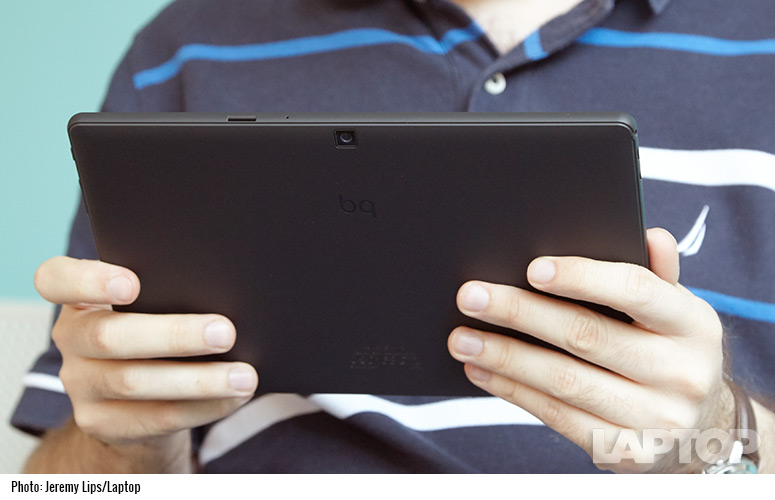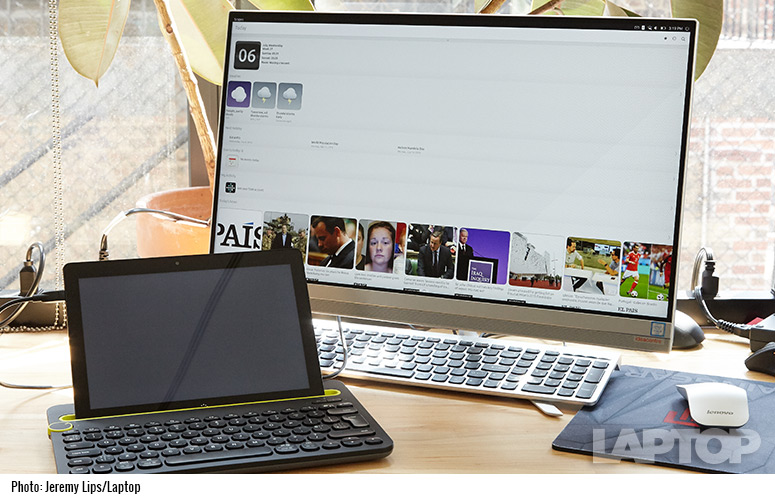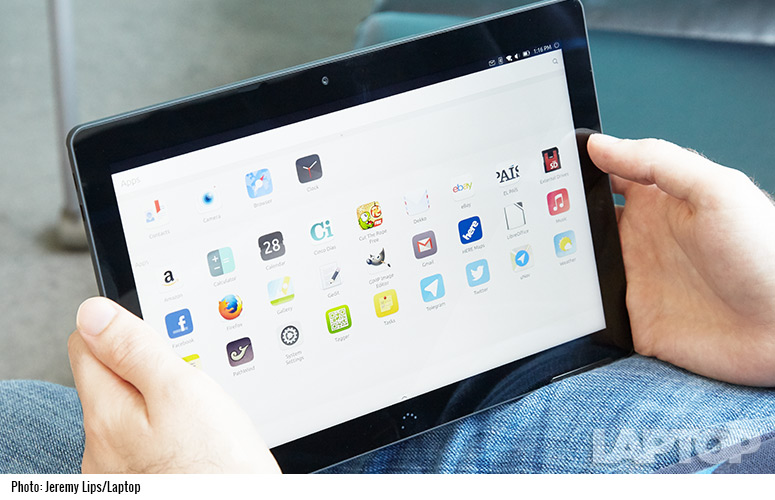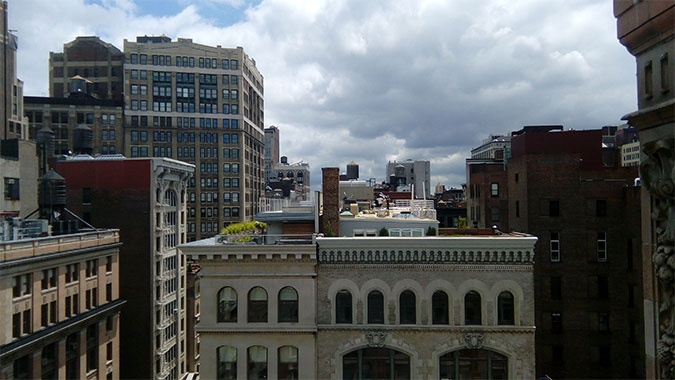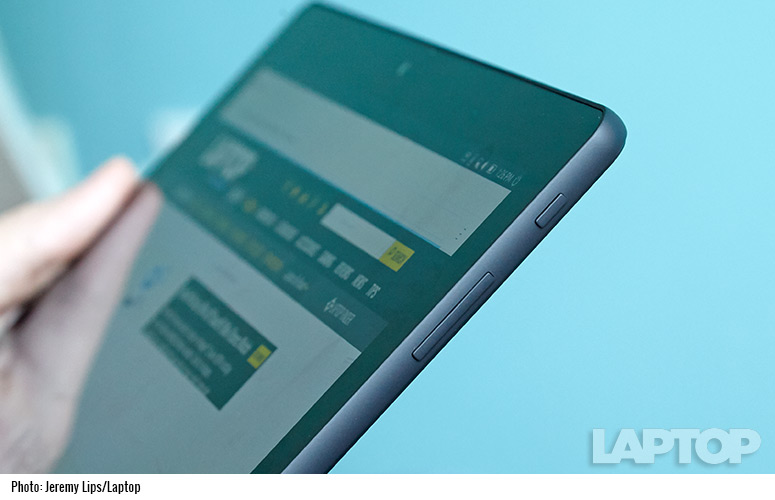Laptop Mag Verdict
The BQ Aquaris M10 Ubuntu Edition runs the Linux operating system out of the box but struggles at multitasking.
Pros
- +
Vivid display
Cons
- -
Not powerful enough
- -
Weak speakers
- -
Runs hot
- -
Apps not touch-optimized
Why you can trust Laptop Mag
If there's ever been a niche device, it's a tablet running Ubuntu. The BQ Aquaris M10 Ubuntu Edition is the first slate to run the Linux operating system. It also doubles as a desktop device when it's plugged into a monitor or used with a mouse and keyboard. Unfortunately, this $312 tablet lacks the horsepower to multitask well, which is frustrating enough that even Ubuntu diehards will want to consider an alternative device that runs iOS, Android or Windows.
Design
The BQ Aquaris M10 looks pretty boring, even for a tablet. The all-black slate has a matte-plastic back with BQ's logo and a rear camera. In addition to the 10.1-inch, 1900 x 1200 display, the front of the device has a camera and BQ's logo placed where a Menu button should go. The misplaced logo quickly became an annoyance, as I pressed it several times expecting to be taken to my app menu, the multitasking screen, settings or another central location.
The Ubuntu tablet is extremely portable, at 1 pound and 9.7 x 6.7 x 0.3 inches. The Acer Iconia One 10 (which also has a 10.1-inch display) is heavier and larger, at 1.2 pounds and 10.2 x 6.6 x 0.4 inches. The Microsoft Surface 3 is 1.4 pounds (1.95 pounds with a Type Cover) and larger, at 10.5 x 7.4 x 0.3 inches. Apple's iPad Air 2 is the lightest and thinnest of the bunch by a hair, at 0.98 pounds and 9.4 x 6.6 x 0.2 inches.
The left side of the tablet is home to the headphone jack, a micro-HDMI port and a micro-USB port. A microSD card slot is located on top of the device.
MORE: Our Favorite Tablets for Work and Play
Ubuntu and Software
Sign up to receive The Snapshot, a free special dispatch from Laptop Mag, in your inbox.
The BQ Aquaris M10 is the first tablet to run the Ubuntu operating system (specifically version 15.04) out of the box. The operating system is optimized for touch, which means you have to learn a whole bunch of new gestures. Swiping in from the right lets you navigate among programs (there is no home button), swiping from the bottom reveals the app drawer and swiping with three fingers from the right allows for split-screen mode. Despite the touch optimization, however, most of the apps are not made for touch screens and are best used in desktop mode.
This version of Ubuntu doubles as a desktop OS, which you can trigger by plugging in a mouse and keyboard. You can also plug the Aquaris into a monitor with an HDMI cable to use the tablet as a mini PC. Desktop mode doesn't change much; it's just the tablet version with a mouse. That means you have to click and drag parts of the OS that you would swipe with your finger. Some apps worked well and remained open with other windows running in the background, but others would quit or force me into full-screen mode.
The BQ Aquaris M10 is one of the slowest pieces of tech I've used in recent memory.
There is a whole bunch of software preinstalled, including Amazon, BBC, BBC Sport, Cnet, Reddit, SoundCloud, Telegram, Twitter, Yelp, LibreOffice, Dekko, Cut the Rope, Gedi and Firefox. Usually, this much software would annoy me, but Ubuntu programs can be hard to find. Those who know Ubuntu well can brave the app store, which is sparse and features a lot of relatively obscure apps.
Display
The Aquaris' 10.1-inch, 1900 x 1200 display produces vivid, accurate colors. When I watched the trailer for "Bleed For This" at full brightness, I saw lot of detail, like the fuzzy padding around the edges of Vinny Paz's Halo device and folds in the plastic wrap he covers himself in to make weight. The blood on his face was a lifelike crimson.
The screen reproduces 98.4 percent of the sRGB color gamut, which is a bit higher than the slate-tablet average of 97 percent. The Iconia One wasn't as vivid, covering just 81 percent, while the Surface 3 and the iPad Air 2 were slightly better, at 99 percent and 100 percent, respectively.
When measured for color accuracy, the Aquaris registered a Delta-E score of 0.7 (0 is best), which is far better than the 2.8 average. The iPad Air 2 also fared well, at 0.9, while the Iconia One notched 1.2. The Surface 3 had a higher-than-average (i.e., worse) Delta-E score of 3.1.
MORE: Kids Tablets to Buy (or Avoid)
Unfortunately, at 300 nits of brightness, the Aquaris' display is darker than its rivals'. That's better than the Iconia One's 266 nits but lower than the category average of 364 nits. The iPad Air 2 and the Surface 3 had much brighter panels, at 368 nits and 407 nits, respectively.
Webcam
The two cameras on the Aquaris take fairly sharp photos, though they tend to be too dark. A 2560 x 1440 selfie I took with the 5-megapixel front camera caught a ton of detail, including the seams on my shirt, individual hairs on my beard and even my eyelashes. The focus, however, was better on my face than it was on the background.
The 8-MP rear camera didn't impress me. A 3328 x 1872 picture I took of some of the neighboring buildings was sharp -- I could make out blades of grass on the next building's roof garden, and patterns in the architecture. This picture was also dark, making it difficult to see details on buildings made with brown bricks. Even the sky, which was a bright blue behind the clouds, appeared darker in the image.
Audio
The two front-facing speakers on the Aquaris are far too quiet. When I listened to Walk The Moon's "Jenny," I pumped up the volume all the way before I was at a comfortable listening volume. Even then, while the vocals were clear, the guitar was slightly muddled and the bass was nonexistent.
Performance
If you want to multitask at all, the BQ Aquaris M10 isn't for you. Its 1.3-GHz MediaTek quad-core MT8163B CPU, 2GB of RAM and 16GB of eMMC storage add up to one of the slowest pieces of tech I've used in recent memory.
The tablet's performance was poor as soon as I plugged a URL into the browser. The Aquaris doesn't support the latest 802.11ac Wi-Fi standard, and sites loaded like it was 2009. I started seeing latency once I had two tabs open, especially when I attempted switching between them, which often triggered a loading symbol.
If all of this sounds bad for a tablet, it's even worse as a desktop computer. The tablet can't power both its own screen and a monitor simultaneously, so the touchpad becomes a giant mouse pad. (I used a Bluetooth mouse to avoid the hassle.)
The Aquaris earned a score of 22.7 on the JetStream JavaScript performance test, just beating the Android-powered Iconia One (21.7). However, the category average for tablets is much higher, at 56.1.
Battery Life
BQ makes no specific battery claims, but the tablet provided decent endurance during our testing. After using the Aquaris M10 lightly for 2 hours -- which included leaving it idle, using a word processor, watching videos and browsing the web -- the tablet's battery was at 79 percent. That extrapolates to 10 hours of battery life, under light use.
The Laptop Mag Battery Test couldn't run on the Ubuntu tablet, but the tablet category average is 8 hours and 58 minutes. The Iconia One lasted 9:13, the iPad Air 2 endured for 9:20 and the Surface 3 survived for 8:01.
MORE: 10 Tablets with the Longest Battery Life
Heat
The Aquaris got steamy when we put it to the test. When we streamed 15 minutes of HD video from Hulu, the back of the tablet reached a balmy 107 degrees Fahrenheit, breaking our 95-degree comfort threshold.
Configuration and Warranty
The $312 BQ Aquaris M10 we tested came with a 1.3-GHz MediaTek quad-core MT8163B CPU, 2GB of RAM, 16GB of eMMC storage and a 1920 x 1200 display.
BQ also offers a second, $255 model of the Aquaris, which is almost identical, with two exceptions: It's white instead of black and has a low-res, 1280 x 800 display. Both configurations of the Aquaris come with a two-year warranty.
Bottom Line
The only good reason to buy the BQ Aquaris M10 Ubuntu Edition is if you've been dying for an Ubuntu tablet and don't want to install the operating system yourself. For $312, you're getting an underpowered tablet with an operating system that you can install on a plethora of other devices for free.
For $155, you can get the Acer Iconia One 10 running Android and install Ubuntu on it yourself (or, of course, use Android). It uses a similar, underpowered processor, but at least you're getting a deal. Those who are interested in a viable desktop mode might want to consider the Microsoft Surface 3 while it's still available. The $386 2-in-1 runs full Windows, works as a tablet and is roughly the same size, at 10.8 inches. You could even install Ubuntu if you're so inclined.
All things considered, almost anything is better than the BQ Aquaris M10 Ubuntu Edition. Between its weak CPU and a suite of apps that lack touch optimization, the company fell woefully short of the mark.
- Best 2-in-1s (Laptop/Tablet Hybrids)
- Best Laptops Under $500
- Best Ultrabooks (Thin-and-Light Windows Laptops)
BQ Aquaris M10 Ubuntu Edition Specs
| Brand | BQ |
| CPU | 1.3-GHz MediaTek Quad Core MT8163B |
| Camera Resolution | 8MP |
| Card Reader Size | 64GB |
| Card Readers | microSD |
| Company Website | https://www.bq.com |
| Display Resolution | 1920 x 1200 |
| Display Size | 10.1 |
| Front-Facing Camera Resolution | 5MP |
| Graphics Chip | MediaTek Mali-T720 MP2 |
| OS | Ubuntu 15.04 |
| Ports | microSD, microUSB, 3.5mm audio jack, microHDMI |
| RAM Included | 2GB |
| Size | 9.7 x 6.7 x 0.3 inches |
| Storage Drive Size | 16GB |
| Storage Drive Type | eMMC |
| USB Ports | 1 |
| Warranty / Support | 3-year commercial warranty, 2-year Legal Warranty Period |
| Weight | 1.03 pounds |
| Wi-Fi | 802.11a/b/g/n |
Andrew is a contributing writer at Laptop Mag. His main focus lies in helpful how-to guides and laptop reviews, including Asus, Microsoft Surface, Samsung Chromebook, and Dell. He has also dabbled in peripherals, including webcams and docking stations. His work has also appeared in Tom's Hardware, Tom's Guide, PCMag, Kotaku, and Complex. He fondly remembers his first computer: a Gateway that still lives in a spare room in his parents' home, albeit without an internet connection. When he’s not writing about tech, you can find him playing video games, checking social media and waiting for the next Marvel movie.
